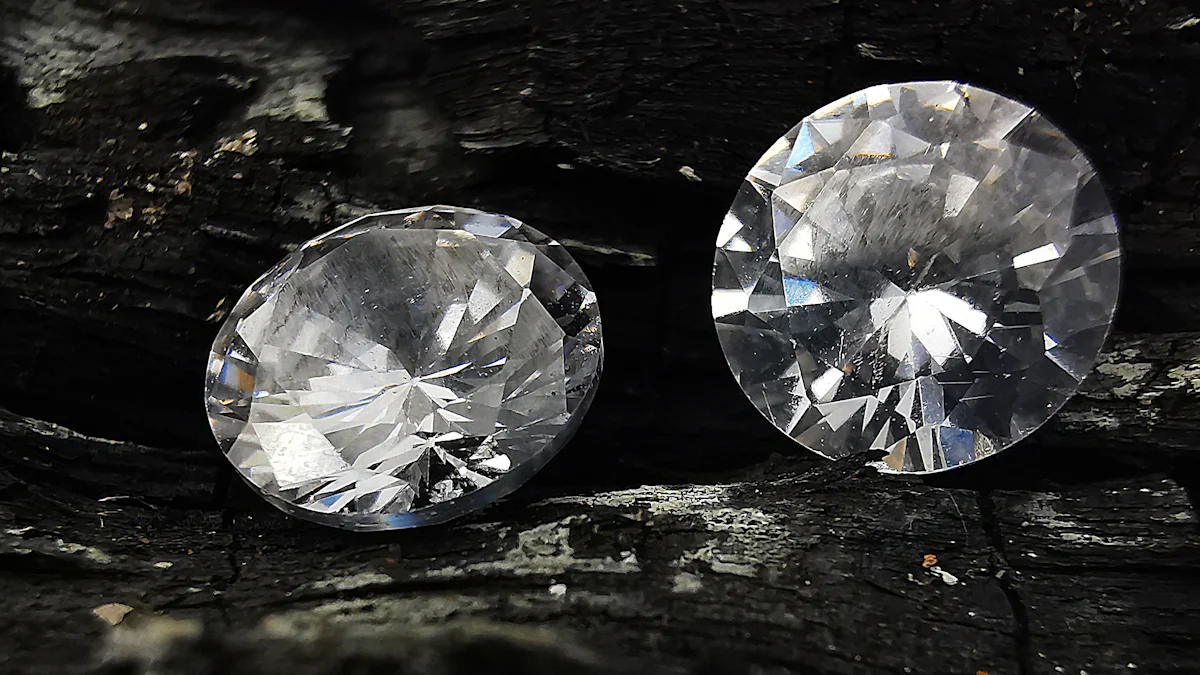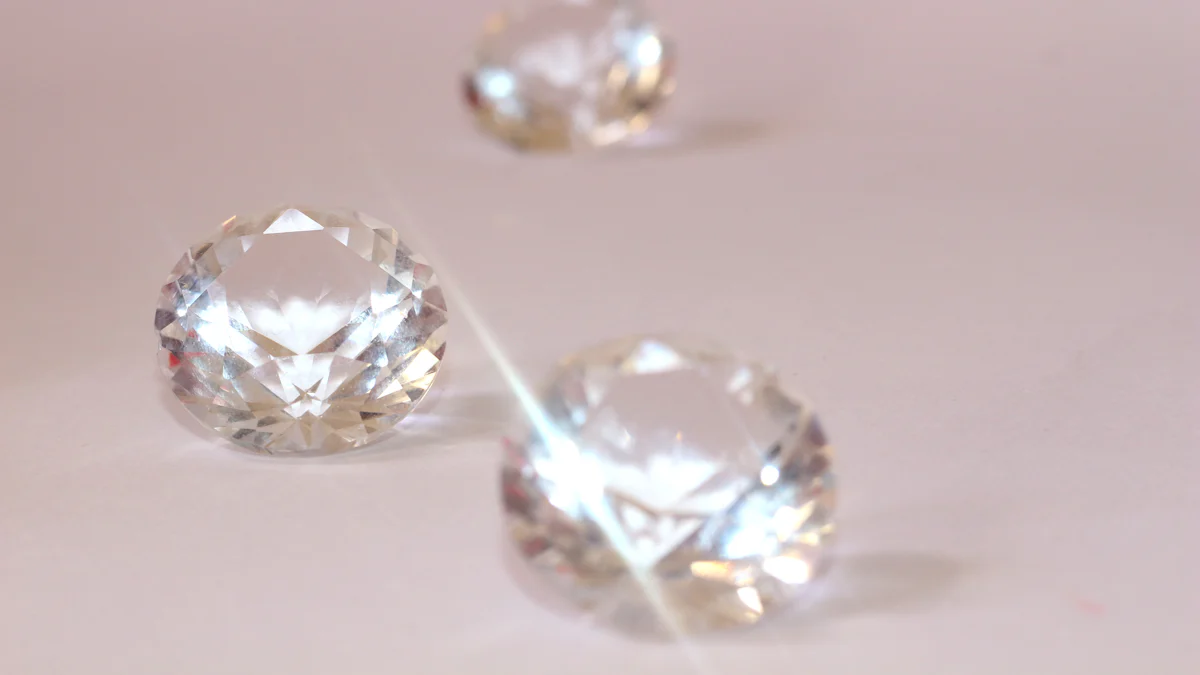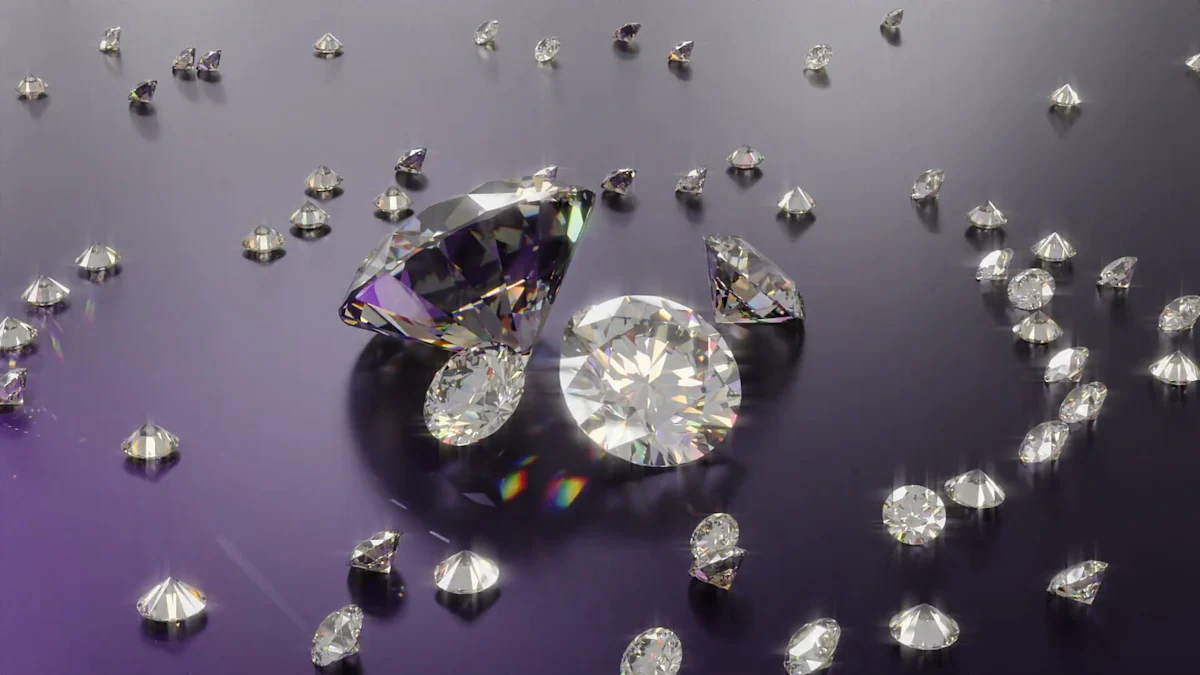Understanding What is a VVS Diamond Guide

When you explore the world of diamonds, understanding what is a VVS diamond becomes essential. VVS stands for "Very, Very Slightly Included," indicating diamonds with tiny imperfections that are nearly invisible without magnification. These diamonds are rare, making up less than 1% of the market, and their exceptional clarity contributes to their high value. Recognizing the importance of diamond clarity helps you appreciate the beauty and rarity of VVS diamonds. This knowledge empowers you to make informed decisions when selecting a gemstone that truly stands out.
Key Takeaways
- VVS diamonds, or 'Very, Very Slightly Included' diamonds, are highly valued for their exceptional clarity, making up less than 1% of the diamond market.
- Understanding the difference between VVS1 and VVS2 diamonds is crucial; VVS1 diamonds have fewer inclusions and are generally more desirable and valuable.
- Prioritize clarity when selecting a diamond, as higher clarity enhances brilliance and can help retain the diamond's value over time.
- Always inspect a diamond under magnification to verify its clarity and ensure it meets your expectations before purchasing.
- Request certification from reputable gemological laboratories like the GIA to guarantee the authenticity and clarity grade of your VVS diamond.
- Consider your budget carefully; while VVS diamonds are stunning, lower clarity grades can offer similar visual appeal at a more affordable price.
- When buying a VVS diamond, ask jewelers about the diamond's clarity grade, and how it compares to others in terms of cut, color, and carat weight.
Understanding VVS Clarity Grades

What is VVS Clarity?
When you delve into the world of diamonds, understanding what is a VVS clarity becomes crucial. VVS stands for "Very, Very Slightly Included." This clarity grade signifies diamonds with minuscule imperfections that are nearly invisible to the naked eye. These tiny inclusions require magnification to be seen, making VVS diamonds highly sought after for their exceptional purity. Their clarity ensures that these diamonds sparkle with unparalleled brilliance, captivating jewel enthusiasts and collectors alike.
VVS diamonds are often chosen for engagement rings and other fine jewelry where clarity is a priority. Their near-perfect gemstone purity makes them a hallmark of quality in the diamond industry. By understanding what is a VVS clarity, you gain insight into why these diamonds hold such a prestigious position among gemstones.
Importance of Clarity in Diamonds
Clarity plays a vital role in determining a diamond's overall beauty and value. When you consider purchasing a diamond, clarity should be a key factor in your decision-making process. The fewer the inclusions, the more light can pass through the diamond, enhancing its brilliance and sparkle.
Diamonds with high clarity grades, like VVS, are rare and therefore more valuable. They offer a visual appeal that is unmatched by diamonds with lower clarity grades. By prioritizing clarity, you ensure that your diamond not only looks stunning but also retains its value over time.
Understanding the importance of clarity helps you appreciate the unique qualities of VVS diamonds. It empowers you to make informed choices, ensuring that your selected gemstone truly stands out in terms of both beauty and rarity.
Differences Between VVS1 and VVS2

When you explore the world of VVS diamonds, understanding the differences between VVS1 and VVS2 becomes essential. These two subgrades of VVS clarity offer unique characteristics that influence their desirability and value.
VVS1 Explained
VVS1 diamonds represent the pinnacle of clarity within the VVS category. These diamonds possess very few inclusions, which are often only visible from the bottom. The minimal presence of imperfections ensures that VVS1 diamonds exhibit exceptional brilliance and sparkle. Jewelers and collectors highly value these diamonds for their superior clarity. When you choose a VVS1 diamond, you select a gemstone that stands out for its near-perfect purity.
VVS2 Explained
VVS2 diamonds, while still possessing high clarity, have slightly more inclusions than VVS1 diamonds. These inclusions may be visible from the top under magnification, but they remain nearly invisible to the naked eye. Despite having more inclusions than VVS1, VVS2 diamonds still offer remarkable clarity and brilliance. They provide an excellent option for those seeking high-quality diamonds at a slightly lower price point than VVS1.
Comparing VVS1 and VVS2
When comparing VVS1 and VVS2 diamonds, clarity serves as the primary differentiator. VVS1 diamonds boast fewer inclusions, making them more desirable and often more valuable. The superior clarity of VVS1 diamonds ensures that they capture and reflect light more effectively, enhancing their visual appeal. In contrast, VVS2 diamonds, while still impressive, have slightly more inclusions, which can affect their overall brilliance.
Cost of VVS Diamonds
When you consider purchasing a VVS diamond, understanding the factors that influence its price is crucial. These diamonds, known for their exceptional clarity, often come with a premium price tag. Let's explore what affects their cost and how they compare to other clarity grades.
Factors Influencing the Price
Several elements contribute to the pricing of VVS diamonds:
-
Clarity Grade: The primary factor affecting the cost is the clarity grade itself. VVS diamonds, which stand for Very Very Slightly Included, have minimal inclusions that are difficult to detect even under magnification. This high clarity level makes them more valuable compared to other diamonds with lower clarity grades.
-
Type of VVS Diamond: Within the VVS category, there are two sub-grades: VVS1 and VVS2. A VVS1 diamond, having fewer and less visible inclusions, typically commands a higher price than a VVS2 diamond.
-
Comparison with Other Clarity Grades: When compared to VS (Very Slightly Included) and SI (Slightly Included) diamonds, VVS diamonds are more expensive. On average, they can be up to 30% more costly than SI diamonds. However, it's important to note that while VVS diamonds are priced higher, they may not always appear significantly different to the naked eye compared to lower-graded diamonds.
-
Other Factors: Besides clarity, other factors such as carat weight, color, and cut also play a significant role in determining the price of a VVS diamond. Larger carat weights, higher color grades, and superior cuts will increase the overall cost.
VVS Diamonds vs. Other Clarity Grades
When deciding whether to invest in a VVS diamond, consider the visual differences and your budget. While VVS diamonds offer near-flawless clarity, VS1 and SI1 diamonds can also appear eye-clean, meaning their inclusions are not visible without magnification. If budget is a concern, you might find that a lower-graded diamond offers similar visual appeal at a more affordable price.
How Clarity is Measured
Understanding how diamond clarity is measured helps you appreciate the value and beauty of VVS diamonds. The clarity of a diamond is one of the key factors that determine its overall quality and worth. Let's explore the methods used to evaluate this important characteristic.
The 4Cs of Diamonds
The 4Cs—Clarity, Cut, Color, and Carat Weight—form the foundation of diamond grading. Each "C" plays a crucial role in determining a diamond's quality and price. Clarity refers to the presence of internal or external imperfections, known as inclusions and blemishes. These imperfections can affect the diamond's ability to reflect light, impacting its brilliance.
- Clarity: This measures the purity of the diamond. Fewer inclusions mean higher clarity.
- Cut: This affects how well the diamond reflects light. A well-cut diamond sparkles more.
- Color: This evaluates the absence of color. Less color means a higher grade.
- Carat Weight: This measures the size of the diamond. Larger diamonds are rarer and more valuable.
Tools and Techniques Used in Clarity Grading
Gemologists use specific tools and techniques to assess a diamond's clarity. The Gemological Institute of America (GIA) has established a globally recognized clarity grading system with 11 distinct grades, organized into six categories from Flawless to Included.
-
10x Magnification: Experts use a loupe or microscope with 10x magnification to examine the diamond. This tool helps them identify inclusions that are not visible to the naked eye.
-
Clarity Scale: The GIA clarity scale includes eleven grades, ranging from Flawless (no inclusions or blemishes visible under 10x magnification) to Included (inclusions visible to the naked eye). VVS diamonds fall into the "Very, Very Slightly Included" category, indicating very small inclusions that are difficult to notice even under magnification.
-
Evaluation Criteria: Gemologists consider several factors when grading clarity:
- Number: The quantity of inclusions present.
- Size: The dimensions of the inclusions.
- Color: The hue of the inclusions, which can affect visibility.
- Placement: The location of inclusions within the diamond.
By understanding these tools and techniques, you gain insight into the meticulous process of clarity grading. This knowledge empowers you to make informed decisions when selecting a diamond, ensuring you choose a gemstone that meets your standards for beauty and quality.
Tips for Buying VVS Diamonds
When you're in the market for a VVS diamond, knowing what to look for can make all the difference. These diamonds, known for their exceptional clarity, require careful consideration to ensure you make a wise investment.
What to Look for in a VVS Diamond
-
Clarity and Size: While VVS diamonds boast high clarity, it's essential to balance this with other factors like size and shape. Larger diamonds or certain cuts may reveal inclusions more prominently. In such cases, opting for a VVS diamond can be beneficial.
-
Budget Considerations: VVS diamonds often come with a premium price tag. Evaluate whether the clarity level justifies the cost for your specific needs. Sometimes, a lower clarity grade can offer similar visual appeal at a reduced price.
-
Visual Inspection: Always inspect the diamond under magnification. Even though VVS diamonds have minimal inclusions, seeing them firsthand ensures you're satisfied with the purchase.
Questions to Ask Jewelers
When purchasing a VVS diamond, asking the right questions can provide valuable insights:
- What is the clarity grade of this diamond? Understanding the specific clarity grade helps you assess its value.
- Can I see the diamond under magnification? Viewing the diamond up close allows you to verify its clarity.
- How does this diamond compare to others in terms of cut, color, and carat weight? This comparison helps you evaluate the overall quality and price.
Certification and Authenticity
Ensuring the authenticity of your VVS diamond is crucial. Look for certification from reputable organizations like the Gemological Institute of America (GIA). A certified diamond guarantees that it has been evaluated by experts and meets the stated clarity grade.
- Check for Certification: Always request a certificate from a recognized gemological laboratory. This document provides detailed information about the diamond's characteristics.
- Verify Authenticity: Use the certificate to verify the diamond's authenticity and clarity grade. This step ensures you're getting what you pay for.
By following these tips, you can confidently navigate the process of buying a VVS diamond. Understanding what is a VVS diamond and its unique qualities empowers you to make informed decisions, ensuring your chosen gemstone stands out for its beauty and rarity.
Understanding what is a VVS diamond enhances your appreciation for these gems. Their exceptional clarity and near-flawlessness make them stand out in the world of gemstones. When you choose a VVS diamond, you select a piece that offers unmatched brilliance and beauty. This knowledge empowers you to make informed decisions, ensuring your investment reflects both quality and value. By prioritizing clarity, you ensure that your chosen diamond not only captivates with its visual appeal but also retains its worth over time.
FAQ
What are VVS diamonds?
VVS diamonds, short for "Very, Very Slightly Included," rank among the highest clarity grades. These diamonds possess tiny imperfections that are nearly invisible without magnification. Their exceptional quality makes them a popular choice for engagement rings and fine jewelry where clarity is a priority.
How do VVS diamonds compare to other clarity grades?
VVS diamonds stand out due to their minimal inclusions, which enhance their brilliance and sparkle. Compared to other clarity grades like VS (Very Slightly Included) and SI (Slightly Included), VVS diamonds offer superior clarity. However, this often comes with a higher price tag.
What is the difference between VVS1 and VVS2 diamonds?
VVS1 diamonds have fewer and less visible inclusions compared to VVS2 diamonds. Inclusions in VVS1 diamonds are typically only visible from the bottom, while VVS2 diamonds may have inclusions slightly more visible from the top. This subtle difference can influence their value and desirability.
Are VVS diamonds worth the investment?
Investing in VVS diamonds can be worthwhile if you prioritize clarity and quality. These diamonds retain their value over time due to their rarity and exceptional clarity. However, if budget is a concern, consider whether the visual difference justifies the cost compared to lower clarity grades.
Can you see inclusions in VVS diamonds with the naked eye?
No, inclusions in VVS diamonds are not visible to the naked eye. These diamonds are often described as "eye-clean," meaning they appear flawless without magnification. This characteristic enhances their appeal in jewelry.
Why are VVS diamonds more expensive?
The high cost of VVS diamonds stems from their rarity and exceptional clarity. The fewer the inclusions, the more valuable the diamond. Additionally, VVS diamonds often come with a premium price due to their desirability in the market.
How should I care for my VVS diamond jewelry?
To maintain the brilliance of your VVS diamond jewelry, clean it regularly with a mild solution of soap and water. Use a soft brush to gently remove dirt and oils. Store your jewelry separately to prevent scratches and consider professional cleaning periodically.
Do VVS diamonds come with certification?
Yes, reputable jewelers provide certification for VVS diamonds from recognized gemological laboratories like the Gemological Institute of America (GIA). Certification ensures the diamond's authenticity and clarity grade, giving you confidence in your purchase.
Can I find VVS diamonds in different shapes and sizes?
Absolutely, VVS diamonds are available in various shapes and sizes. Whether you prefer a classic round cut or a unique shape like pear or emerald, you can find VVS diamonds to suit your style and preferences.
What should I consider when buying a VVS diamond?
When purchasing a VVS diamond, consider factors like clarity, size, and budget. Inspect the diamond under magnification to ensure satisfaction with its clarity. Ask for certification to verify its authenticity and compare it with other diamonds in terms of cut, color, and carat weight.
See Also
Your Ultimate Resource for Choosing a Stunning Ruby Ring
A Comprehensive Look at Engagement Ring Diamond Cuts
A Detailed Process for Picking a White Diamond Ring

